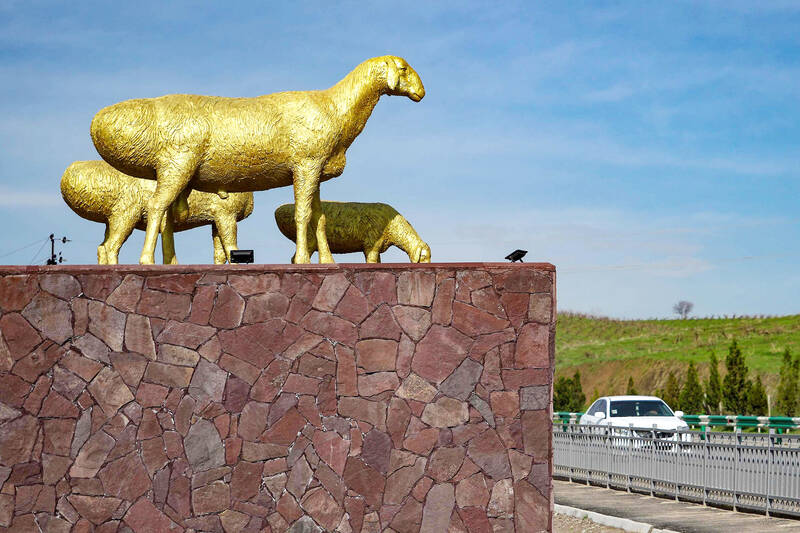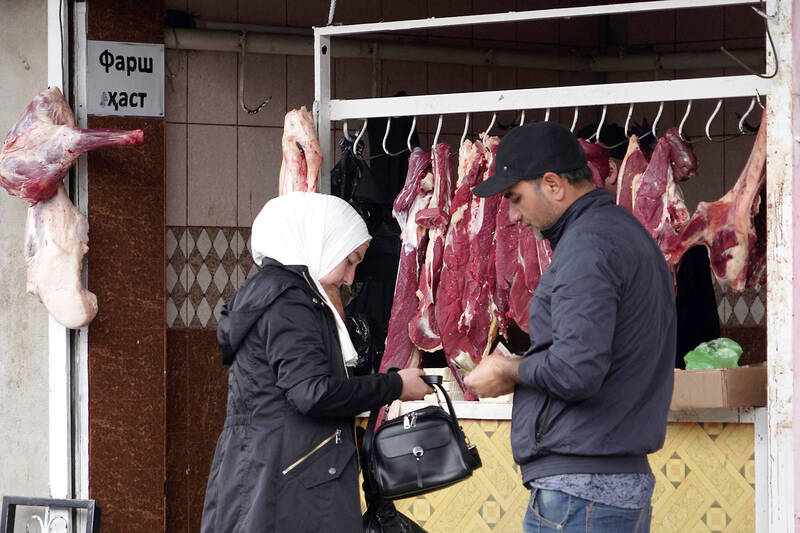In the hills outside the Tajik capital Dushanbe, shepherd Bakhtior Sharipov was watching over his flock of giant Hissar sheep.
The breed, prized for profitability and an ability to adapt to climate change, garners celebrity status in the Central Asian country, which is beset by a shortage of both meat and suitable grazing land.
“They rapidly gain weight even when there is little water and pasture available,” 18-year-old Sharipov said.

Photo: AFP
Facing a serious degradation in farmland due to years of overgrazing and global warming, the hardy sheep offer a potential boon to Tajikistan’s farmers and plentiful supply of mutton to consumers.
Around 250 of the animals — instantly recognizable by two fatty lumps on their rear end — were grazing in the early spring sun under Sharipov’s watch. “These weigh an average of 135 kilograms (300 pounds). It’s the end of winter, so they’re not as heavy, but they’ll put on weight quickly,” he said.
A white Central Asian shepherd dog, almost as large as the sheep he was watching over, stood on guard.

Photo: AFP
The largest Hissar rams can weigh over 210 kilograms (460 pounds).
Able to yield meat and fat of around two-thirds their total weight — more than most other breeds, many of which also consume more — they can be highly profitable for farmers.
‘IMPROVE THE LAND’

Photo: AFP
“The Hissars are a unique breed, first because of their weight,” said Sharofzhon Rakhimov, a member of the Tajik Academy of Agricultural Sciences.
“Plus these sheep never stay in the same spot so they contribute to improving the land’s ecosystem,” he said. They can wander up to 500 kilometers (300 miles) in search of grazing land between seasons, helping pastures in different regions regenerate. The decline in land quality is one of the main environmental challenges facing Central Asia. Around 20 percent of the region’s land is already degraded, affecting 18 million people, according to a UN report.
That is an area of 800,000 square kilometers (nearly 310,000 square miles), equivalent to the size of Turkey.
The dust churned up by the arid ground can fuel cardio-respiratory diseases.
Facing a hit to their livelihoods as their land becomes ever less productive, many farmers choose to emigrate.
In such an environment, the status of Hissar sheep — able to thrive in the tough conditions — is of serious public interest for Tajikistan.
Among the dozens of posters glorifying Tajik President Emomali Rahmon that line the road into the Hissar valley, stands a golden-colored monument to the three kinds of Hissar sheep.
EXPENSIVE SHEEP
At his biotech center near the capital, scientist and breeder Ibrokhim Bobokalonov harnesses genetic samples of the very best specimens in the hope of rearing the largest and most profitable sheep. “Demand for Hissar sheep is growing not only in Tajikistan, but also in Kazakhstan, Kyrgyzstan, Russia, Turkey, Azerbaijan, China and even the US,” Bobokalonov said.
The animals have even become a source of rivalry in the region.
Tajikistan recently accused its neighbors of tampering with the breed, crossing it with other local varieties to create even heavier sheep.
A Hissar weighing 230 kilos was recorded at an agricultural competition in Kazakhstan last year, setting a Guinness World Record. Others in Kyrgyzstan have surpassed 210 kilos. Tajik breeders say they are intent on staying ahead. “Here’s Misha. He weighs 152 kilograms and is worth $15,000,” Bobokalonov said, standing in front of a sheep lying on the scales with its legs tied together.
The sum is equivalent to six years’ average salary in Tajikistan. Bobokalonov plans to sell him later this year.
“I hope that by the time of the competition this summer, he will weigh 220-230 kilograms. Just by feeding him natural products, without doping, he can put on around 800 grams a day,” Bobokalonov said.
In Kazakhstan, a sheep sold for US$40,000 in 2021.
While farmers like the Hissars for their profitability, the sheep is famed among the wider population for its flavor.
Mutton is an essential ingredient in central Asian fare.
Scouring the offering at a local market, shopper Umedjon Yuldachev agreed.
“You can cook any Tajik national dish with this mutton.”

The unexpected collapse of the recall campaigns is being viewed through many lenses, most of them skewed and self-absorbed. The international media unsurprisingly focuses on what they perceive as the message that Taiwanese voters were sending in the failure of the mass recall, especially to China, the US and to friendly Western nations. This made some sense prior to early last month. One of the main arguments used by recall campaigners for recalling Chinese Nationalist Party (KMT) lawmakers was that they were too pro-China, and by extension not to be trusted with defending the nation. Also by extension, that argument could be

Aug. 4 to Aug. 10 When Coca-Cola finally pushed its way into Taiwan’s market in 1968, it allegedly vowed to wipe out its major domestic rival Hey Song within five years. But Hey Song, which began as a manual operation in a family cow shed in 1925, had proven its resilience, surviving numerous setbacks — including the loss of autonomy and nearly all its assets due to the Japanese colonial government’s wartime economic policy. By the 1960s, Hey Song had risen to the top of Taiwan’s beverage industry. This success was driven not only by president Chang Wen-chi’s

Last week, on the heels of the recall election that turned out so badly for Taiwan, came the news that US President Donald Trump had blocked the transit of President William Lai (賴清德) through the US on his way to Latin America. A few days later the international media reported that in June a scheduled visit by Minister of National Defense Wellington Koo (顧立雄) for high level meetings was canceled by the US after China’s President Xi Jinping (習近平) asked Trump to curb US engagement with Taiwan during a June phone call. The cancellation of Lai’s transit was a gaudy

The centuries-old fiery Chinese spirit baijiu (白酒), long associated with business dinners, is being reshaped to appeal to younger generations as its makers adapt to changing times. Mostly distilled from sorghum, the clear but pungent liquor contains as much as 60 percent alcohol. It’s the usual choice for toasts of gan bei (乾杯), the Chinese expression for bottoms up, and raucous drinking games. “If you like to drink spirits and you’ve never had baijiu, it’s kind of like eating noodles but you’ve never had spaghetti,” said Jim Boyce, a Canadian writer and wine expert who founded World Baijiu Day a decade